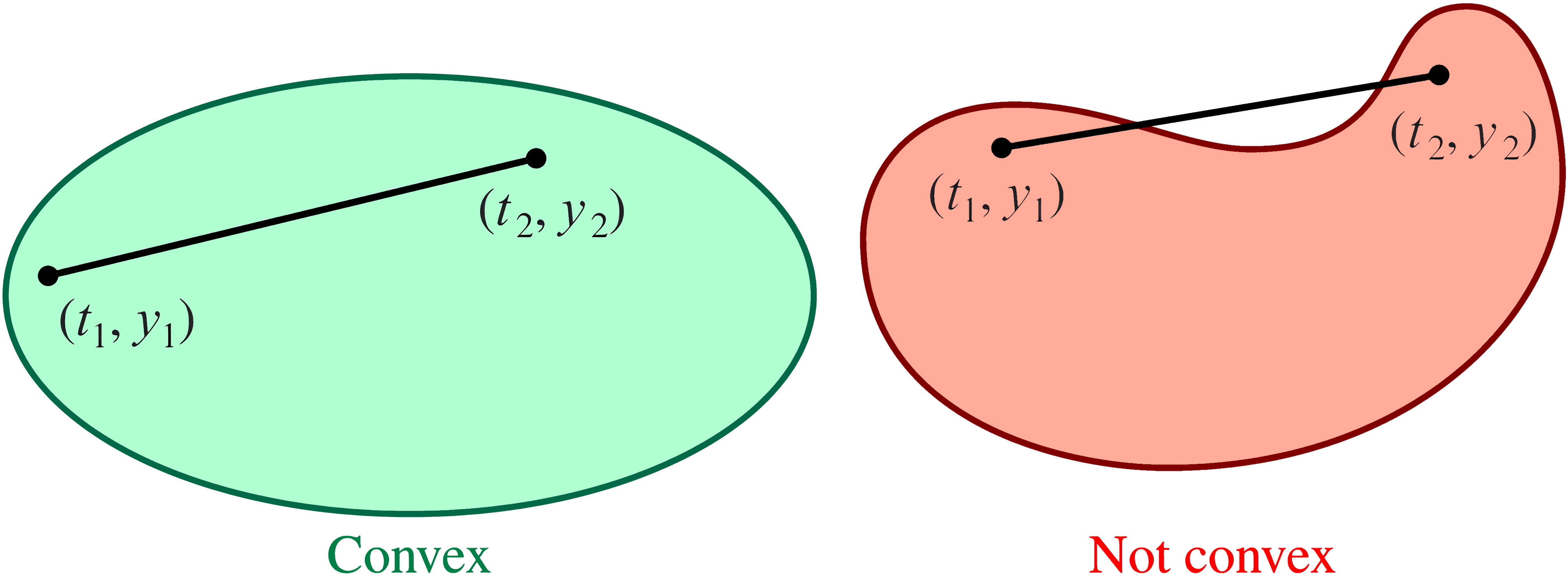6.2. The elementary theory of initial-value problem#
In this section, we will look at many approaches for approximating the solution of a (well-posed) initial-value problem (IVP) using grid points. The first-order Ordinary Differential Equation (ODE) is written as,
If \(y(a) = \alpha\) is known, then the following first-order ODE equation is an IVP:
The following definition is Definition 5.1 from [Burden and Faires, 2005].
Limit of a function
Let \(f(t,y)\) be a function, where \(t\) is a independent variable and \(y\) is a dependent variable, defined on a domain \(D\subset \mathbb{R}^{2}\). In addition, if
then it is said that \(f\) satisfies the Lipschitz condition in the variable \(y\), and \(L\) is known as the Lipschitz constant.
Example: \(f (t, y) = t y^2\) does not satisfy any Lipschitz condition on the region \(D = \{(t, y)~|~0 \leq t \leq T \}\). However, \(f (t, y) = t y^2\) satisfies Lipschitz condition on the region \linebreak \(D = \{(t, y)~|~0 \leq t \leq T,~-Y \leq y \leq Y \}\) where \(T\) and \(Y\) are some real numbers [Gu, 2022].
The following example is based on an example from [Burden and Faires, 2005].
Example: Demonstrate that \(f (t,~y) = t| y|\) satisfies a Lipschitz condition on the interval \(D = \{(t,~y)~|~1 \leq t \leq 2\text{ and }- 3 \leq y \leq 4\}\).
Solution: For any pair of points \((t,~y_{1})\) and \((t,~y_{2})\) from \(D\), we have,
The above shows that \(f\) satisfies a Lipschitz condition on D in variable \(y\) and with Lipschitz constant 2. Therefore, for this problem, the smallest Lipschitz constant would be \(L = 2\), as, for example, \vspace{-0.5cm}
Triangle inequality
For any real numbers \(\alpha\) and \(\beta\), we have [Rudin, 1976], \vspace{-0.5cm}
The following definition is Definition 5.2 from [Burden and Faires, 2005].
Limit of a function
Set \(D\subset \mathbb{R}^{2}\) is called convex if any two points of this domain can be connected using a line while all points on this line stay in the set. In other words, for any two points \((t_{1}, y_{1}), (t_{2}, y_{2}) \in D\),

Fig. 6.1 An example of convex set (left) and not convex set (right). This is Figure 5.1 from [Burden and Faires, 2005] with some modifications.#
The following theorem is Theorem 5.2 from [Burden and Faires, 2005].
Theorem
Assume that \(D\subset \mathbb{R}^{2}\) is a convex set and \(f(t,y)\) is defined on this set. If a constant \(L>0\) exists such that
then \(f\) satisfies the Lipschitz condition in the variable \(y\) and \(L\) is the Lipschitz constant.
The following definition is Theorem 5.4 from [Burden and Faires, 2005].
Theorem
Assume that domain \(D = \{ (t, y):~a\leq t \leq b,~-\infty<y< \infty\}\) and \(f\in C(D)\). If \(f\) satisfies a Lipschitz condition on \(D\) in the variable \(y\), then the IVP \cite{burden2005numerical},
has a unique solution \(y(t)\) when \(a\leq t \leq b\).
The following definition is Definition 5.5 from [Burden and Faires, 2005].
Remark
Roughly speaking, an IVP is said to be a well-posed problem if it has a unique solution whose value varies only negligibly if initial conditions change by a small value.
The following theorem is Theorem 5.6 from {cite:ps}`burden2005numerical.
Theorem
Assume that domain \(D = \{ (t, y):~a\leq t \leq b,~-\infty<y< \infty\}\) and \(f\in C(D)\). If \(f\) satisfies a Lipschitz condition on \(D\) in the variable \(y\), then the IVP [Burden and Faires, 2005],
is well-posed.
